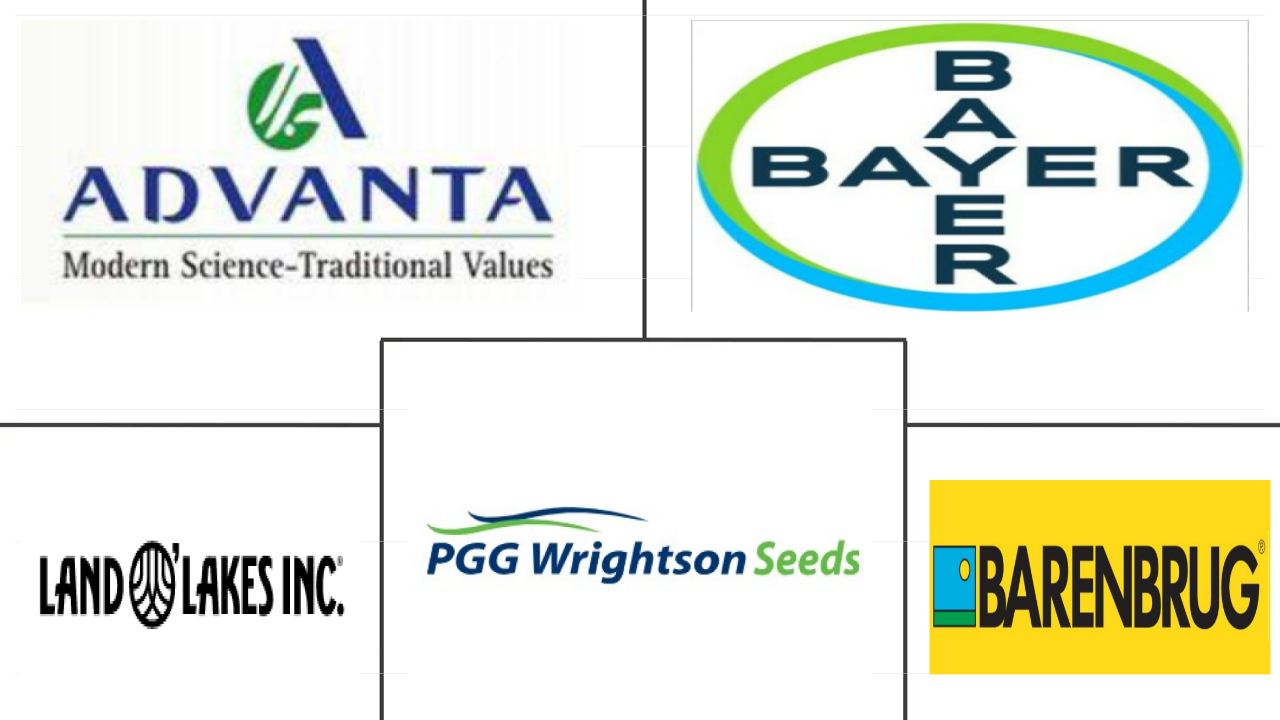Market Size of asia-pacific forage seed Industry
| Icons | Lable | Value |
|---|---|---|
|
|
Study Period | 2017 - 2030 |
|
|
Market Size (2024) | USD 698 Million |
|
|
Market Size (2030) | USD 821.5 Million |
|
|
Largest Share by Breeding Technology | Hybrids |
|
|
CAGR (2024 - 2030) | 2.75 % |
|
|
Largest Share by Country | Japan |
Major Players |
||

|
||
|
*Disclaimer: Major Players sorted in no particular order |
Asia-Pacific Forage Seed Market Analysis
The Asia-Pacific Forage Seed Market size is estimated at 698 million USD in 2024, and is expected to reach 821.5 million USD by 2030, growing at a CAGR of 2.75% during the forecast period (2024-2030).
698 Million
Market Size in 2024 (USD)
821.5 Million
Market Size in 2030 (USD)
3.48 %
CAGR (2017-2023)
2.75 %
CAGR (2024-2030)
Largest Market by Crop
24.95 %
value share, Alfalfa, 2023
There has been an increase in alfalfa demand from dairy farmers, and the governments of China and Japan are supporting the production of forage crops.
Largest Market by Country
48.62 %
value share, Japan, 2023
Favorable government policies and increasing domestic feed consumption for the growing livestock population have boosted the demand for forage seeds in the country.
Fastest-growing Market by Crop
3.69 %
Projected CAGR, Forage Sorghum, 2024-2030
The segment is the fastest-growing in Asia-Pacific due to an increase in the demand for animal feed, high protein content, and availability of high-quality seeds.
Fastest-growing Market by Country
4.65 %
Projected CAGR, Philippines, 2024-2030
The increase in the cultivation of forage crops with commercial seeds is due to the rising demand for feed by dairy farmers owing to the growing cattle population.
Leading Market Player
22.06 %
market share, Advanta Seeds - UPL, 2022

It has made effective partnerships and product innovations. It signed an agreement with Seed-X, an Israel-based company, to provide higher-quality seeds in the region.
Hybrids dominated the region's forage seed market due to higher yield and palatability to animals
- In Asia-Pacific, hybrid seeds dominate the forage seed market in terms of volume and value compared to open-pollinated varieties and hybrid derivatives. In 2022, hybrid forage seeds held an 80.6% share of the region's forage seed market, which showed a significant growth of 22.3% between 2017 and 2022. It is due to the high yield, early maturity, and higher palatability to livestock.
- In 2022, non-transgenic hybrid seeds dominated the market among the hybrid seed segment, with more than 99% in the region. This is mainly due to the large use of non-transgenic seeds compared to GMO seeds because of the perceived effects of transgenic traits on livestock and animal health and the ban on transgenic crops in major countries, including India.
- In 2022, among the non-transgenic hybrid seeds, alfalfa was the major crop, holding a 19.9% value share in the market, followed by forage corn with 10.1%. This is due to the larger area under alfalfa cultivation and the ban on transgenic alfalfa in some countries such as India, Bangladesh, and Pakistan.
- Open-pollinated varieties and hybrid derivatives accounted for a 19.4% share of the region's forage seed market in 2022. Alfalfa leads the segment, which accounted for a 45.6% share of OPV in the region. Due to the high-volume seed requirements and lack of hybrid innovations, OPVs are more prevalent in forage crops such as alfalfa, forage sorghum, and other forages in the Asia-Pacific region.
- India is the fastest-growing country, with 36.1% of the region's OPV share. The lower share compared to hybrids is mainly due to low productivity.
- Therefore, non-transgenic forage seeds under hybrid seeds dominate the market. With the aforementioned facts, the market is anticipated to grow during the forecast period.
Japan dominated the forage seed market in the region, with a higher area under cultivation due to increased livestock population in the country
- In 2022, Asia-Pacific accounted for 15.1% of the global forage seed market. The market value increased by 19.4% between 2017 and 2022 due to the increased demand for forage from feed processing industries.
- Japan is the largest consumer of forage seeds and held a market share of 48.8% of the region's forage seed market in 2022, mainly due to increased cultivation and rising demand from the feed industry.
- In India, alfalfa is the major crop consumed, accounting for 25% of the Asia-Pacific forage seed market in 2022. The higher demand was due to the high production area and increased cattle population. For instance, the cattle population increased from 300 million heads in 2017 to more than 305 million heads in 2021, mainly due to the increased demand for dairy and meat products. Therefore, increased demand is estimated to increase the area under cultivation, thus driving the seed market.
- In 2022, apart from Japan, other countries such as India, Australia, and China together held the maximum market share value of 44.6%, mainly due to the higher cattle population in these countries and higher demand for feed.
- In Japan, the Ministry of Agriculture, Forestry and Fisheries (MAFF) set a goal of increasing forage self-sufficiency from 77% to 100% by 2030. To support forage production in the country, MAFF provides support payments to growers who plant forage and feed crops. Therefore, the demand for seeds is projected to rise in the country in the coming years.
- Factors such as government support to increase production, the rising adoption of commercial seeds, and the growing demand for forage seeds are estimated to boost the market in the region during the forecast period.

